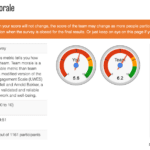Data and metrics are not synonymous. Let’s tackle that misunderstanding right out of the gate. Data is a number or set of numbers. “Three days.” There. That’s data. Is it useful to you? Of course not, because you have no context to go with it. Metrics is the context and measurement of where, and under […]
Notes from a Tool User
Scrum by Example – Same Old Song in Sprint Retrospective
The World’s Smallest Online Bookstore team has just come out of their Sprint Review. For those who’re keeping score, the team committed to a Sprint Goal: Have basic reader review system in place so book buyers can see a variety of opinions about a book. Their plan included completing seven Product Backlog Items and fixing […]
Scrum by Example – Don’t Let Sprint Review be a Missed Opportunity
When last we left our World’s Smallest Online Bookstore team, their Sprint was rocky. To have an effective Sprint Review story, let’s assume that they magically wound back the clock (shazam!) and implemented the changes. As a result, they had the more effective Sprint Planning that we discussed in the last blog post. So let’s […]
Scrum by Example – How Sprint Planning Mistakes Can Derail a Team
Sprint Planning is the most underappreciated Agile event. Unfortunately, that leads to a whole host of errors and problems, as we will soon see. The ScrumGuide says: “Sprint Planning initiates the Sprint by laying out the work to be performed for the Sprint. This resulting plan is created by the collaborative work of the entire […]
Red-Yellow-Green Status Reports and Other Models – How They Should and Shouldn’t Be Used
Red-Yellow-Green status reports are a widely-used tool to help executives have a fast and simple understanding of the current state of a project through a visual model that makes it easy to spot patterns. Green means everything is good, yellow means there’s some risk, and red means the project is in serious trouble. Simple, right? […]
How Escape Rooms Teach About Teams
Mark and his wife, Doris, along with a small group of their friends, have become very good at solving challenges and escaping locked rooms. In their first escape room in 2015, they were two puzzles away from success but failed to get out. So they changed the team membership. Over the years, they failed another […]
Agile Retrospectives
What is the difference between an Agile Retrospective and a Post Mortem? Retrospectives are the foundation of Continuous Improvement and Short Feedback loops.
What is the Recommended Scrum Team Size?
Nearly every client I work with asks me this question at some point. The Scrum Guide offers very limited guidance, suggesting 3-9 people per team (exclusive of ScrumMaster and Product Owner), without giving reasons or context for those numbers. There isn’t one universally correct answer for optimal team size, but there are a number of […]







